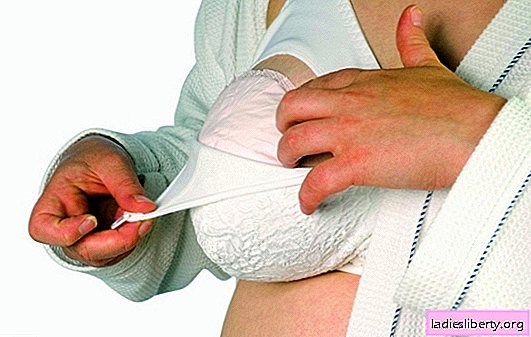
All 40 weeks of a woman's pregnancy are accompanied by changes in her body. The breast also changes - the body prepares for lactation, so the nipples swell, and colostrum is secreted. The mammary glands are preparing for the upcoming feeding of the baby, so a pregnant woman may need disposable breast pads.
Many expectant mothers worry about how safe colostrum is for an unborn baby. Indeed, the discharge serves as a signal of the state of the uterus. Unpleasant symptoms are proof that the woman’s body is not all right and that a gynecologist should be consulted.
Colostrum during pregnancy - causes
The reason for colostrum during pregnancy is the secretion of the hormone prolactin in the body, which affects lactation. Colostrum is not always a sign of pregnancy; it can also stand out before menstruation.
The excretion of colostrum in women begins at different times, so the body of each person is individual. However, in the early stages of discharge, they rarely appear, usually this occurs in the second trimester or a little later.
Several myths are associated with colostrum secretion:
• If a pregnant woman produces a lot of colostrum, there will be no problem feeding the baby. In fact, the appearance of colostrum does not affect future lactation, so you should not worry about secretions;
• Discharge means pregnancy. Some women believe that delay and colostrum are sure signs of pregnancy. However, discharge may also appear due to diseases such as mastitis or hormonal imbalance;
• Colostrum is a sign that a pregnant woman will give birth soon. In some women, colostrum is secreted in the first months of pregnancy, when the abdomen is almost invisible.
So, colostrum can appear both in the early stages and at the end of pregnancy. There may be no discharge at all, since prolactin is produced differently in all.
Colostrum during pregnancy - diagnosis
Colostrum during pregnancy is an ordinary and natural process. Consultation with a gynecologist will not be superfluous, since in some cases, discharge may indicate a pregnant woman's state of health. It is worth paying attention to:
• Milk color. Usually colostrum is liquid, translucent, liquid or viscous, white-yellow. Sometimes it can acquire an orange tint due to excess vitamin A.
In the last months of pregnancy, red blotches may appear, which is the norm. However, it is worth visiting a surgeon and a mammologist to make sure that the pregnancy is proceeding well;
• Fatigue and bad smell. Colostrum smells good and tastes sweet. If colostrum smells unpleasant and has a green color, this may be a sign of infection. Often the disease goes away with fever, weakness and swelling of the nipples. Such an infection is dangerous for the unborn child and is treated with special drugs, so you need to urgently go to the gynecologist;
• The volume of discharge. Large volumes are one of the options for the norm, however, not the discharge itself is dangerous. In some, a rush of early milk to the chest provokes excessive secretion of oxytocin. This hormone stimulates uterine contractions, which can cause an early birth or miscarriage. With abundant secretion of milk, a pregnant woman should be tested for hormones prolactin and estrogen and visit her gynecologist;
• Lumps in the chest. If the breast swells, increases and a feeling of heaviness appears, this is considered normal. If the mammary glands are deformed, seals appear, it is worthwhile to consult a doctor as soon as possible. Seals can be cysts or tumors, so you can not delay;
• The shape of the nipples. If one breast has increased in size, it is worth visiting a doctor. The reasons for the asymmetry may be a problem with the mammary ducts, mammary glands or a tumor;
• Discomfort. When colostrum is excreted during pregnancy, itching or tingling may appear, without causing severe discomfort. If the discharge is accompanied by stretching pain in the lower back, this may be a sign of an early miscarriage or early birth. You need to visit a gynecologist and lie down for preservation if necessary.
Not all symptoms are disturbing; they may be a variation of the norm. You need to visit doctors on time, follow the recommendations and be less nervous - this will badly affect the fetus.
Most often, the discharge appears in the second or third trimester, at which time the hormone prolactin is produced more intensely. Isolation of the first colostrum occurs at 20-36 weeks (depending on the characteristics of the pregnant woman).
Some note the appearance of milk by 12-18 weeks, in the very first trimester of pregnancy. In others, the first discharge appears during childbirth or even after the birth of a baby. Any option is considered the norm, and do not worry about this. The only alarming factors are the deterioration of well-being and the greenish color of colostrum.
Colostrum during pregnancy - what to do?
If there is too much colostrum, you should use disposable breast pads. It is worth changing them regularly, every 3-4 hours, so that bacteria do not multiply in them.
Breast should be washed with warm water, without soap or wet wipes. Wipe your breasts gently with a soft and clean towel. Perform such procedures at least twice a day. You can also use a moisturizer from the very beginning of colostrum. This will prevent stretch marks and cracks in the chest, as well as pain caused by stretching the skin on the chest.
Nutrition should be balanced, with a sufficient content of all vitamins, as well as fats. It is proper nutrition that improves the health of women, the fetus, and the nutritional value of colostrum and breast milk.
Colostrum during pregnancy - how dangerous is it for an unborn baby?
Colostrum of white or yellow color and a pleasant smell is absolutely safe for the unborn child and is a variant of the norm. You should be wary in case of an unpleasant smell or color.
Colostrum is produced in every woman at the very beginning of pregnancy, but its secretion is not always noticeable. The ducts of the mammary glands can have an expanded network, because of which the fluid does not need to go out. Colostrum in the early stages is the same norm as its absence.
The appearance in the colostrum of blood secretions at the end of pregnancy does not happen often, but does not harm the fetus. Blotches appear due to expansion of the ducts, rebuilding of the mammary gland and rupture of small capillaries.
Itching and bursting in the mammary glands in the second or third trimesters are normal and safe for the unborn child. This is a signal of preparing the ducts and breast for lactation, the future feeding of the baby. If there are no other unpleasant symptoms, you should not consult a doctor.
Isolation of colostrum during pregnancy in any quantity and at any time is the norm, however, it is worth remembering that discharge from the chest is associated with the condition of the uterus (contractions occur when feeding the baby in the uterus). Discharges accompanied by pain or feeling unwell may indicate illness or abnormality. For any warning or unpleasant symptoms, you should consult a doctor to prevent a possible threat to the fetus.











